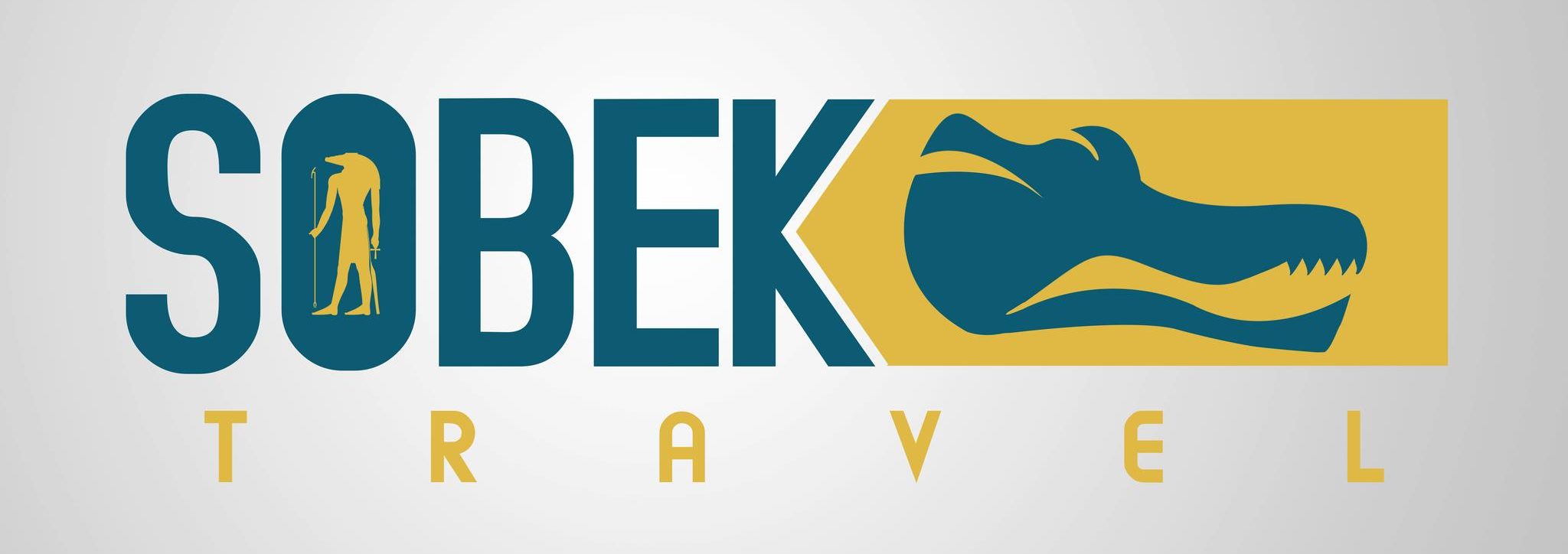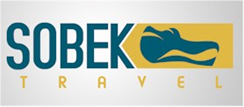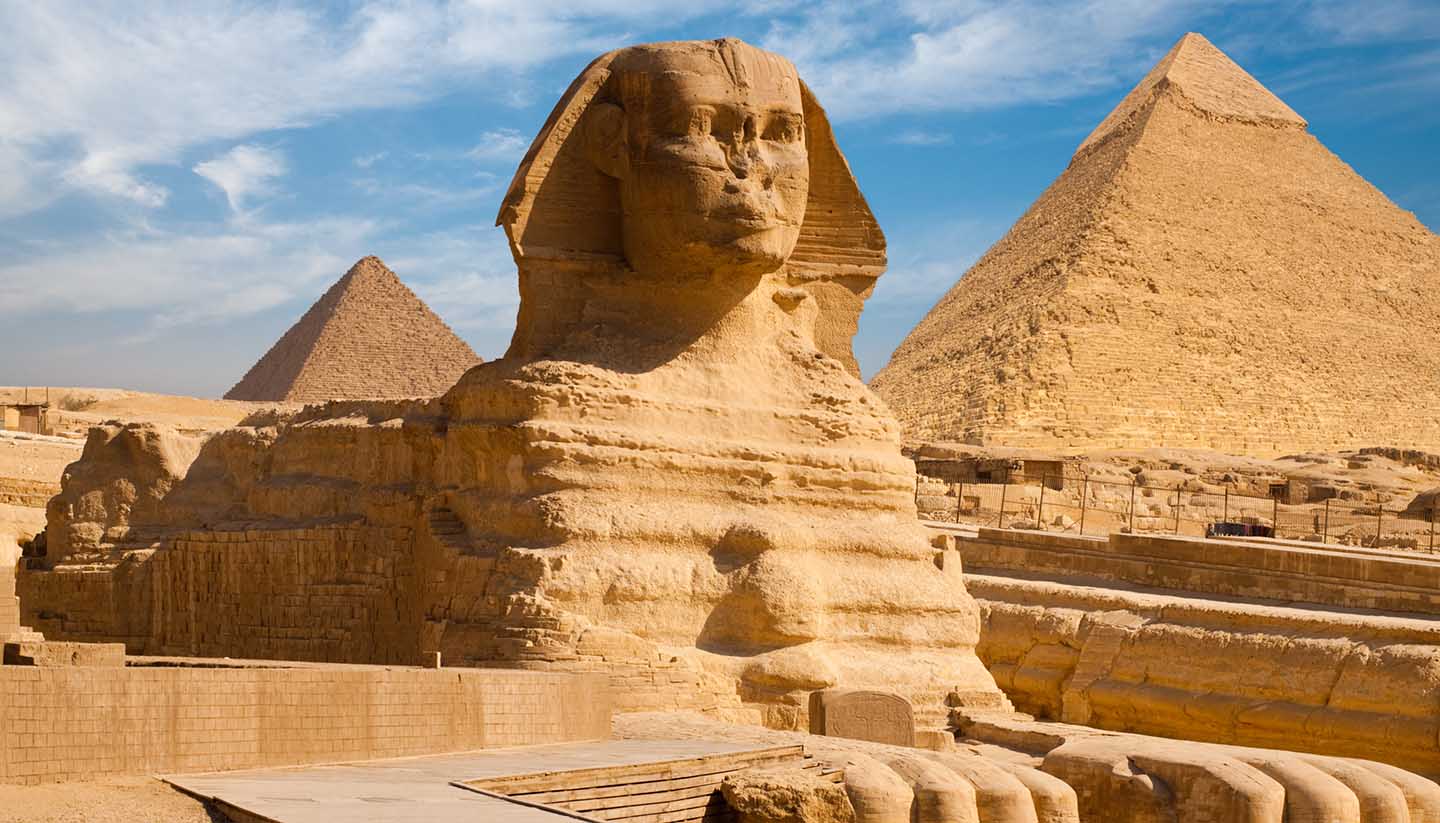History
The regularity and richness of the annual Nile River flood, coupled with semi-isolation provided by deserts to the east and west, allowed for the development of one of the world’s great civilizations.
A unified kingdom arose around 3200 B.C. and a series of dynasties ruled in Egypt .for the next three millennia. The last native dynasty fell to the Persians in 341 B.C., who in turn were replaced by the Greeks, Romans, and Byzantines. It was the Arabs who introduced Islam and the Arabic language in the 7th century and who ruled for the next six centuries.
A local military caste, the Mamluks, took control about 1250 and continued to govern after the conquest of Egypt by the Ottoman Turks in 1517.
Following the completion of the Suez Canal in 1869, Egypt became an important world transportation hub, but also fell heavily into debt.
Ostensibly to protect its investments, Britain seized control of Egypt’s government in 1882, but nominal allegiance to the Ottoman Empire continued until 1914. Partially independent from the UK in 1922, Egypt acquired full sovereignty following World War II.
The completion of the Aswan High Dam in 1971 and the resultant Lake Nasser have altered the time-honored place of the Nile River in agriculture and the ecology of Egypt.
A rapidly growing population (the largest in the Arab world), limited arable land, and dependence on the Nile all continue to overtax resources and stress society. The government has struggled to prepare the economy
for the new millennium through economic reform and massive investment in communications and physical infrastructure.
Geography
Egypt is largely a desert, an extension of the great Sahara that bands North Africa. Save for the thin strip of watered land along the Nile River, very little could survive here. As the ancient Greek philosopher Herodotus stated: “Egypt is the gift of the Nile”.
Climate
Generally, the summers are hot and dry and the winters, moderate. November through March are definitely the most comfortable months for travel in Egypt.
there is almost no rain in the Nile valley, so you won’t need wet weather gear!
The climate, however, does vary a little bit depending on where you are in the country.
On the north coast along the Mediteranean Sea, a thin strip of land stretching from the sea to 50 km southwards receives some of the most heavy rain in the country during winter months.
Thunderstorms along with heavy rain showers that often last several hours are not uncommon here such as in Alexandria, Marsa Matruh and all other costal areas, and even the Delta.
In some years the rainstorms can last for a whole day or so, though the rain tends to be less heavy. Hail is also not uncommon, especially out in the desert where the weather is usually colder and allows for ice to fall and even frost to form on non-rainy days.
In the Sinai Mountains and also the Red Sea mountains, which stretch along the east side of the country along the shore of the Red Sea, there is generally more rain as rain clouds tend to develop when warm air evaporates and rises as it moves across higher terrain.
Floods in these areas are a common weather phenomenon as so much rain can fall in a very short amount of time (often a day or two), with thunder and lightning as well. Because of the desert and lack of abundant vegetation, the water from the rain quickly falls down across the hills and mountains
and floods local areas. In fact, every year there are stories in the local newspapers about flashfloods in areas of the Sinai and also in Upper Egypt (southern Egypt) such as in Assiut, Luxor, Aswan, Sohag, etc.
These floods, however, only generally happen two or three times a
year, and often do not happen at all in some years, depending on the weather.
When they happen though, it is often in early times of the season such as in September, October or late winter such as February or March (often the rainiest season in Egypt).
Thus, one should be careful when venturing out into the desert or camping in certain areas as water can suddenly rush down from the nearby mountains and hills.
It can sometimes carry a quite strong current that has been known to break down homes of rural people who build their homes from mud,
bricks, and other weak materials. It is not surprising to hear that some people drown in the floods, which is strange for a desert country that doesn’t receive much precipitation.
Also, in higher elevations such as on top of the Sinai mountains, temperates can drop much more than the surrounding areas, allowing for snowfall in winter months, since temperatures can drop down to below freezing, as well as formation of frost even in the low lying desert areas where the temperatures are generally several degrees colder than in the cities.
December and January are usually the coldest months of the year, although it is normally warmer the further south you go and within the bigger cities.
Visitors should be aware that most houses and apartments in Cairo and Egypt do not have central heating like countries with colder climates as the main weather concern in Egypt is the heat. Therefore, even though the weather might not be so cold for the Western travelers, inside the apartment it might be even colder as the temperature inside homes is generally a few or
several degrees colder than out in the street.
Holidays
Banks, shops and businesses close for the following Egyptian National Holidays (civil, secular),
and public transport may run only limited services:
– 7th January (Eastern Orthodox Christmas)
– 25th January (Police day)
– 25th April (Sinai liberation Day)
– 1st May (Labour Day)
– 23rd July (Revolution Day)
– 6th October (Armed Forces Day)
– 1st Shawwal,the 10th Hijri month (Eid Elfitr)
– 10th Tho-Elhejjah, the 12th Hijri month (Eid Al-adha)
Ramadan
Ramadan dates
– 2011 (1432): Aug 1 – Aug 29
– 2012 (1433): Jul 20 – Aug 18
– 2013 (1434): Jul 9 – Aug 7
The festival of Eid ul-Fitr is held after the end of Ramadan and may last several days. Exact dates depend Ramadan is the ninth month of the Islamic calendar and the most important month in the
Islamic Calendar for Muslims, the majority religion in Egypt. Commemorating the time when God revealed the Qur’an to Mohammed, during this holy month, Muslims abstain from eating, drinking or smoking until after sundown on each day. Although strict adherence to Ramadan is
for Muslims only, some Muslims appreciate that non-Muslims do not take meals or smoke in public places.
During Ramadan, many restaurants and cafes won’t open until after sundown.
Public transport is less frequent, shops close earlier before sunset and the pace of life (especially business) is generally slow.
As expected, exactly at sunset minute, the entire country quiets down and busy itself with the main meal of the day (iftar or breaking-fast) that are almost always done as social events in large groups of friends. Many richer people offer (Tables of the Gracious God)
in Cairo’s streets that cater full-meals for free for the passers-by, the poorer ones or workers who couldn’t leave their shifts at the time. Prayers become popular ‘social’ events that some like to enrich with special food treats before and after. An hour or two later, an astonishing springing to life of the cities takes place. Streets sometimes richly decorated for the whole month have continuous rush hours till very early in the morning. Some shops and cafes make the biggest chunk of their annual profit at this time of year. Costs of advertising on television and radio soars for this period and entertainment performances are at their peak.
Cities
– Cairo – the capital of Egypt, home to the Giza Pyramids, the Egyptian Museum and fabulous Islamic architecture
– Alexandria – Egypt’s window on the Mediterranean, with still-palpable glimpses of the past
– Aswan – a more relaxed option, full of amazing sights
– Luxor – gateway to the Valley of the Kings, amongst other fabulous attractions
– Hurghada – a town on the Red Sea, filled with all-inclusive resorts and diving
Other destinations
– Abu Simbel – a very remote town in the far south, with some beautiful ancient temples
– Dahab – backpacker central, with excellent scuba diving
– Gilf Kebir – an oasis deep in the desert with evocative WWII wrecks and prehistoric rock
– Karnak – scattered temples built with an emphasis on size, an impressive avenue of
ram-headed sphinxes runs through the middle
– Lake Nasser – created by the Aswan Dam
– Memphis & Saqqara – both filled with relics and ruins of ancient Egypt, they’re often
combined as a day trip from Cairo
– Sharm el-Sheikh – a hugely popular resort town on the Sinai peninsula, with some of the
best scuba diving in the world
– Siwa – a stunning remote oasis near the Libyan border
– Valley of the Kings
Get in
As a major tourist destination whose economy is dependent upon tourist money, Egypt is relatively easy to enter and/or obtain visas for if necessary. There are three types of Egyptian visa:
– Tourist Visa – usually valid for a period not exceeding 3 months and granted on either a single or multiple entry basis
– Entry Visa – required for any foreigner arriving in Egypt for purposes other than tourism, e.g. work, study, etc. The possession of a valid Entry Visa is needed to complete the residence procedure in Egypt.
– Transit Visa – rarely needed and only for certain nationalities
Entry visas may be obtained from Egyptian diplomatic and consular missions abroad or from the Entry Visa Department at the Travel Documents, Immigration and Nationality Administration (TDINA). Non-Egyptian travelers are required to have a valid passport.
Citizens of many countries may obtain a visa on arrival at major points of entry; the fee is demanded on arrival and it is expensive to change money and then pay the fee.
At airports, you must obtain these from a bank office before passport control, ostensibly to verify that the
currency is real; however, you will have no problem obtaining one. Check with your nearest
Egyptian Consular mission for more details concerning visa regulations applying to your
citizenship.
The fees for a single-entry visa are US$15
Citizens of Bahrain, Guinea, South Korea, Libya, Oman, Saudi Arabia, United Arab Emirates and Yemen receive a 3 month visa on arrival. Citizens of Kuwait can obtain 6-month Residence Permit upon arrival. China and Malaysian citizens receive a 15 day visa on arrival.
Citizens of the following countries are currently required to have a visa before arriving, which must be applied for through an Egyptian consulate or embassy outside of Egypt:
Afghanistan, Algeria, Armenia, Azerbaijan, Bangladesh, Bosnia-Herzegovina, Croatia, Georgia,
Indonesia, Iraq, Iran, Israel, Kazakhstan, Kirghizia, Lebanon, Macedonia, Malaysia (if you intend to stay for more than 15 days), Moldova, Montenegro, Morocco, Pakistan, Palestine, the
Philippines, Russia, Serbia, Sri Lanka, Tajikistan, Thailand, Tunisia, Turkmenistan, Turkey,Ukraine, Uzbekistan, Vietnam and all African countries (except citizens of Guinea and Libya, who do not require visa).
Visitors entering Egypt at the overland border crossing at Taba or at Sharm el Sheikh airport can be exempted from a visa and granted a free fourteen day entry visa to visit the Aqaba coast of the Sinai peninsula, including Sharm el Sheikh, Dahab and St. Catherine’s Monastery.
Visitors wishing to leave the Sinai peninsula and to visit Cairo and other Egyptian cities are
required to hold full Egyptian visas, although strictly speaking there is a small possibility no one will check for this unless you attempt to exit the country. These are not issued at the Taba border crossing and must be acquired in advance either in the country of residence, at the Egyptian consulate in Eilat or airport upon arrival. Visitors traveling on organized tours often may be able to have their visas issued at the border, but you should verify in advance with their travel agent or tour operator if this option is available to them. Those in possession of a residence permit in Egypt are not required to obtain an entry visa if they leave the country and return to it within the validity of their residence permit or within six months, whichever period is
less.
Tourists visiting Sharm-el-Sheikh who are planning to undertake scuba diving outside local areas (i.e. Ras Mohammed) will need to obtain the tourist visa, because this technically means leaving the Sharm-el-Sheikh area and leads to the requirement for a visa. Officials on boats may check dive boats whilst on the waters so you are advised to obtain the visa beforehand:
there may be fines involved for you and the boat captain if you are caught without the appropriate visa. Most reputable dive centers will ask to see your visa before allowing you on trips.
Egypt has peaceful relations with Israel, but the degree of friendliness varies, and with it, the direct connections between the two countries. As of Dec. 2009, the direct air service between Cairo and Tel Aviv has been suspended for some years. Bus service seems to continue, as
described below.
In any case, verify the situation as you plan, and again at the last minute.
By plane
Egypt has several international airports:
– Cairo International Airport — the primary entry point and the hub of the national carrier Egyptair (see website ).
– Alexandria Nozha
– Luxor International Airport — now receiving an increasing number of international scheduled flights, mostly from Europe, in addition to charter flights.
– Aswan International Airport
– Hurghada International Airport — receives a number of charter flights
– Sharm El-Sheikh International Airport — receives a number of charter flights.
– Burg Al-Arab International Airport
– Marsa Alam International Airport
By boat
Ferries run regularly from Aqaba across to Nuweiba on Egypt’s Sinai peninsula, bypassing Israel and the sometimes complicated border arrangements.
Generally there is no visa fee for entering Jordan through Aqaba since it is a part of the free trade zone. The line to Nuweiba is operated by ABMaritime, see their website for the ‘official’ timetable and current prices.
There is more information about the boat crossing in the itinerary Ferries in The Red Sea A weekly ferry also runs between Wadi Halfa in Sudan and Aswan in Egypt. Ferry boats also
between the Red Sea coast to ports in Saudi Arabia and Jordan.
By bus
Travelers can easily access Egypt by bus from Israel from the bus stations in Jerusalem and Tel Aviv. You will take a bus to Eilat where you can cross over the border into Taba and take a bus to Cairo or into the Sinai. The Jordanian state bus company, JETT, also operates a direct bus between Amman and Cairo which leaves at 03:00 from the JETT terminal in Amman and takes
approximately 19 hours to reach Cairo. Generally, only two or three buses leave from Taba to the various destinations each day: one in the morning and one in the afternoon and sometimes one in the early evening. You should plan your arrival by bus in Eilat accordingly, and be prepared to spend the night in either Eilat or Taba if you will arrive in the evening.
All foreigners must pay a 63LE tax at a small office after the bus leaves the station. Also, be aware that all of the routes by bus must by necessity cross Israel; keep this in mind if you plan on further to travel to Syria, Iran, Libya, or other countries which routinely deny entry to those with evidence of travel to Israel in their passports.
By car
Gas is rather inexpensive in Egypt, prices are heavily subsidized, and they have recently fallen to under USD$1.25/gallon. If you decide to rent a car, you will not add significantly to the cost through gas. Car rental sites require you to be at least 21 years old.
Driving in Egypt is very different than in a Western country and is not for the faint of heart; unless you really need this option it is just as easy and probably cheaper to travel by taxis and around the country by airplane, train, and/or bus. As you will see shortly after arrival, obedience of traffic laws is low and there are very few signs indicating road rules.


